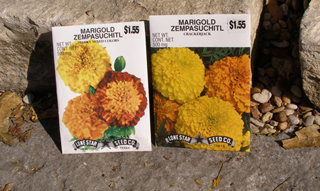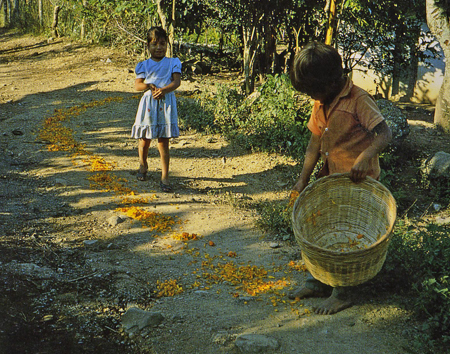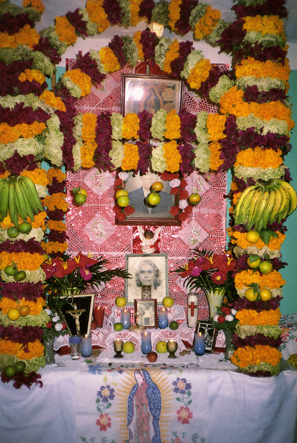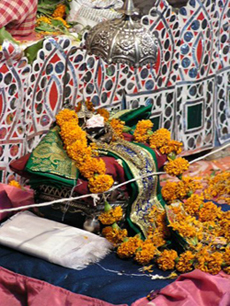Human Flower Project
Thursday, December 06, 2007
On the Trail of Zempasúchitl
Jill Nokes tracks marigolds from India back to their homeland in Mexico, asking how this flower first made its way abroad—with ceremonial punch intact. The plot, like mole sauce, thickens….

Marigold seed, suitable for worldwide celebration
Photo: Jill Nokes
By Jill Nokes
Earlier this fall, I was fascinated by a HFP story about pandals, those ephemeral shrines in West Bengal dedicated to Durga, a Hindu goddess of feminine power. The accompanying photo showed extravagant arrangements of pink lotus flowers and tables draped with long garlands of marigolds. The story explained how marigold flowers are also thrown into fire pits in a purification rite. The pandals reminded me of some of the more elaborate ofrendas (home altars) in Mexico lovingly constructed to honor departed loved ones during the Day of the Dead fiestas. I wondered how the marigold became an important flower in sacred celebrations in continents so far apart.
By chance and good fortune I have followed the marigold trail before. A few years ago we were hiking in El Cielo, a biosphere preserve in Tamaulipas, Mexico, that contains the northernmost cloud forest in our hemisphere. The foothills of the Sierra Madre rise 4,000 feet above the otherwise steamy mattoral (thornscrub) ecosystem that dominates the rest of the state. Instead, the landscape at El Cielo (closer to our home than Colorado) seems more like Guatemala or Costa Rica, with abundant waterfalls, orchids and bromeliads, pine trees and maples, sweetgums and magnolias festooned with wild begonias.
A friend who had done research in El Cielo urged us to seek out a certain young family living in one of the biosphere’s villages. He said we could help support the ejideros (communal landowners) by buying a meals or services there as part of the plan to promote ecotourism. So one day we left the research station at El Canindo and hiked a winding trail past one village towards the next cluster of houses nestled in the sheep-sheared green-carpeted hills. We asked an old man where the family lived, and he pointed to a low ridge where a concrete block house painted tempera-paint blue was perched. We followed a goat trail in that direction and as we drew near, we saw that the dirt path to the house was strewn with vivid marigold petals: it was November first, All Saint’s Day.

Children sprinkle marigold petals leading to the local cemetery
for El Dia de los Muertos (Day of the Dead) in Alta, Puebla, Mexico
Photo: The British Museum, from The Skeleton at the Feast
by E. Carmichael and C. Sayer
In Day of the Dead celebrations, marigolds are used for both decoration but also to guide and welcome the spirits of the beloved deceased back to the fiesta where their favorite food, drink, and family await them. The pungent fragrance of marigolds is said to represent the smell of death, and also the short duration of life. (Once, while hiking in Jalisco in early November, each step we took released the sharp aroma of licorice: we were walking on fields of dried hierba anise, a type of annual marigold.) Marigolds (Tagetes spp.) include about sixty different species of annuals and perennials originating in the New World. In Mexico they are called Zempasúchitl (also variously spelled as Cempasúchil or Cempazúchitl), the old pre-conquest Nathuatl name. (Nathuatl was the lingua franca of Mesoamerica, and many place names and common nouns are still called by their ancient moniker).
 Ofrenda, altar for the Day of the Dead in Chicontepec, Veracruz, Mexico with cempasúchil and mano de leon (coxcomb)
Ofrenda, altar for the Day of the Dead in Chicontepec, Veracruz, Mexico with cempasúchil and mano de leon (coxcomb)
Photo: Chloe Sayer, from The Skeleton at the Feast
So how and when did zempasúchitl travel to India and become an important element in that culture’s religious celebrations? Surely someone has written a dissertation about this somewhere. Mexican marigolds, along with chiles, chocolate, and vanilla, must have been part of that great exchange that introduced cinnamon, sesame, and peanuts to the New World, where they are now essential ingredients of the famous mole (pronounced mole- A) sauce.
The poet and novelist John Phillip Santos calls this blending and cross-pollination of cultures the globalization of meztisaje. Because of their unique history of isolation preceding the “epic rendezvous” with Europe in the fifteenth century, Latin America—and especially Mexico—possess overlooked wisdom and experience to offer a modern world straining to accommodate populations on the move, to answer questions of identity and belonging, and to mitigate fear of “outsiders.” We may think mole is an indigenous regional cuisine, but many of the “essential” ingredients actually came from the Old World (once in Zaachila, we watched the molinero pour animal crackers into the Molino or mill, along with a customer’s personal blend of chiles, chocolate, and other ingredients to make the basis for their mole sauce. The animal crackers served as sweet thickeners.) These assumptions of origins are easily unraveled. It’s like having your mother’s mitochondrial DNA analyzed, thinking you will confirm the link in your ancestry to William, Prince of Orange, only to find that you are actually a distant cousin to Pocahontas.
 Marigolds decorate an offering to Durga
Marigolds decorate an offering to Durga
during Durga puja in Calcutta
Photo: Sandy Ao
But back to zempasúchitl. One explanation for its use in these autumnal celebrations must surely be because, like ruby coxcombs, bachelor buttons, and goldenrod, fall is when the blooms appear. A popular cultivated species of marigold (Tagetes erecta), is actually called African marigold, though we know now that it never grew in Africa until someone planted it there. In turn, true African weeds like Lion’s ear (Leonotis leonurus), asphodel (Asphodelus luteus), and castor bean (Ricinius communis), have become naturalized in the roadsides and overgrazed fields of Mexico. Now it’s hard to imagine a Mexican landscape without them—or burros and goats, either—yet none were known until Europeans brought them in what ecological historian Alfred Crosby calls, “their portmanteau biota.” Marigold petals may guide the dead home on their annual visit, but for the living they lead to some surprising connections with our extended family here on earth.




